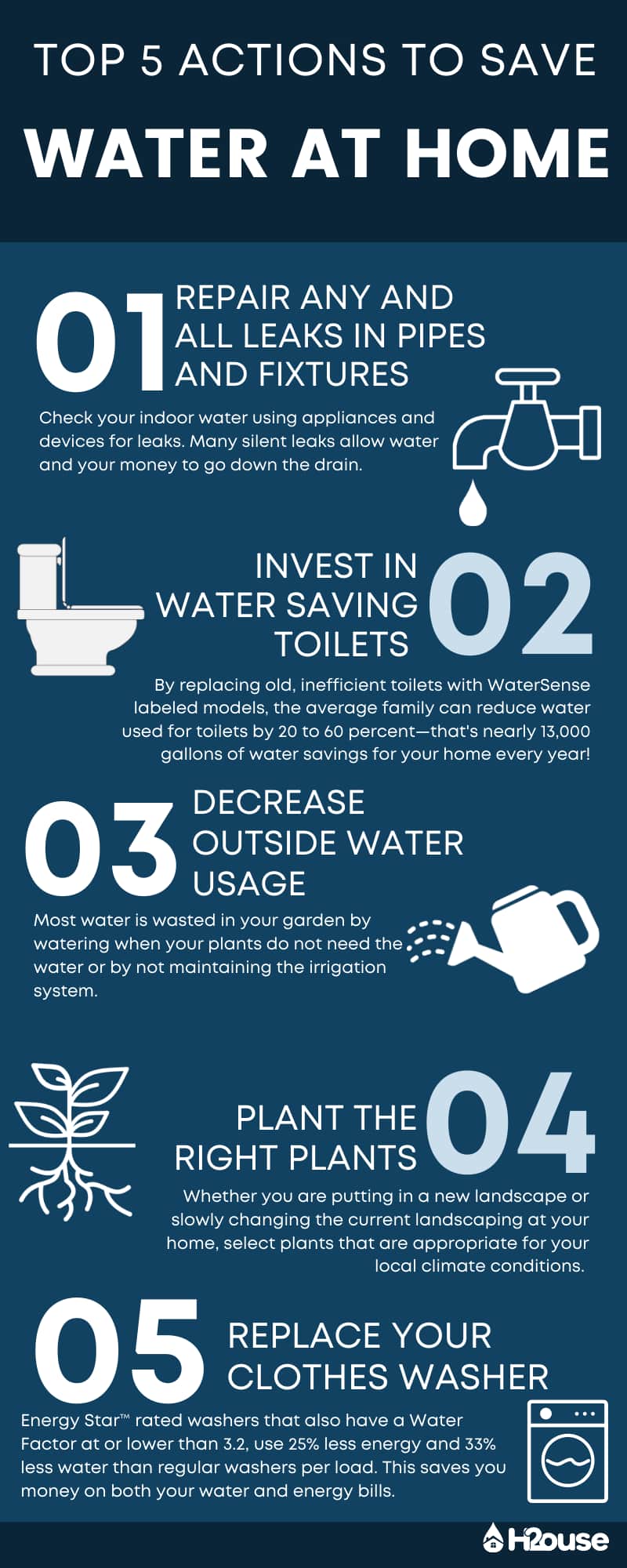With so many ways to save water, here are the highlights for 5 key actions to help you capture the water savings around your home.

1. Repair any and all leaks in pipes and fixtures.
Faucets, showerheads and toilets should be checked regularly for leaks. Any leaks found should be corrected immediately. An aerator can be installed to reduce water volume without affecting the actual water pressure.
A toilet with a leak can cause a loss of about 200 gallons of water daily. Make sure all leaks (no matter how big or small) are repaired quickly.
Many silent leaks allow water and your money to go down the drain. To help detect unseen leaks, you can read your water meter before and after a one-hour period when no water is being used. Studies have shown homes can waste more than 10% due leaking, which costs both you and the environment.
Another large water waster can be leaks in your irrigation system. Fix irrigation system leaks quickly and check for water in the gutters or mud puddles.
Inspect your sprinklers and drip sprayers regularly for leaks during the daytime since the optimal time to water is in the nighttime hours when you cannot observe leaks. If you have an older irrigation system, over 50% and even more than 75% of the water can be lost to leaks.
2. Replace your old Toilet, the largest water user inside your home.
By replacing old toilets with high-efficiency WaterSense labed models, which use 1.28 gallons per flush, the average family can save water up to 60 percent on every flush.
3. Decrease outside water usage.
The best time to water your lawn is between the hours of 10 p.m. and 6 a.m. (early morning hours are best) in small intervals.
Watering lawns during these hours allows water to be absorbed by lawn and plants effectively because there is little chance the water will evaporate in the sun’s heat.
Hydrating lawns in small intervals gives the water an opportunity to seep into the soil and absorb. A good way to water lawns would be to water the lawn for a five minute interval, followed by allowing to water to absorb for 10 minutes and then repeat.
Most water is wasted in your garden by watering when your plants do not need the water or by not maintaining the irrigation system.
Be attentive if you are manual watering by setting your oven timer or some other reminder to move the water promptly.
Make sure your irrigation controller has a rain shutoff device and that it’s appropriately scheduled. Most water is wasted in months prior to or just after the rainy season when intermittent rains occur.
You can also consider installing a weather adjusting ET irrigation controller that automatically saves water by not watering when the plants don’t need the water, check with your local water provider to inquire if ET controllers work in your area.
Most local water agencies give discounts to help reduce the cost of switching to efficient and money-saving appliances. The amount discounted varies by city and county, so it is important you contact the local agency in your area.
4. Plant the right plants with proper landscape design & irrigation.
Whether you are putting in a new landscape or slowly changing the current landscaping at your home, select plants that are appropriate for your local climate conditions.
Having yard with 100% lawn turf area in a dry desert climate uses significant amounts of water. Also consider the trend towards Xeriscape™ and a more natural landscape or wildscape.
Many local water agencies also provide discounts and refunds for alleviating lawns. The LADWP offers up to $5 rebate per sq. ft. for replacing turf with California Friendly landscape that uses drip irrigation.
5. Replace your Clothes Washer, the second largest water user in your home.
Energy Star™ rated washers that also have a Water Factor at or lower than 3.2, use 25% less energy and 33% less water than regular washers per load. This saves you money on both your water and energy bills. There is a current qualifying products listing of water efficient clothes washer models maintained by the Consortium for Energy Efficiency.
